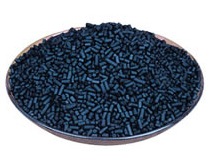Product Center
Contact Us

Guangdong Zhongke Water Purification Materials Co., Ltd.
Address: 1/F, Building No. 5, No. 255, Guantai Avenue, Nancheng District, Dongguan City, Guangdong Province
Address: No. 100, Qima Road, Jingjia Town, Huantai County, Zibo City, Guangdong Province (factory)
Address: Qilidian, Train Station North, Licheng County, Shanxi Province (factory)
Tel.: 0769-22817929 22817976
Fax: 0769-22424976
E-mail: gdzkpac@126.com
Website: www.gdzkjscl.com www.gdzkpac.com

 Your current position:Home > Product Center >
Your current position:Home > Product Center >
Coal Columnar Activated Carbon
< ReturnCoal columnar activated carbon is black columnar particles refined with high-quality anthracites through advanced process; it has reasonable pore structure and good absorption performance. Besides,
Ordering hotline: 0769-22817929
- Detailed introduction
Product Description:
Coal columnar activated carbon is black columnar particles refined with high-quality anthracites through advanced process; it has reasonable pore structure and good absorption performance. Besides, it is inexpensive, has high mechanical strength and can be regenerated repeatedly. In general, it is used for purification of poisonous gases, waste gases treatment, purification of water for industrial and domestic use, and solvent recovery.
Physical and Chemical Performance Analysis
|
Analytical item |
Test Data |
Analytical item |
Test Data |
|
Iodine value |
>800mg/g |
Intensity |
>92% |
|
Specific surface area |
>850m 2 /g |
Methylene blue value |
120-150mg/g |
|
Total pore volume |
>0.8cm 3 /g |
Residual chlorine adsorption rate |
≥85% |
|
0.45-0.55g/cm 3 |
|
|
|
|
In the table, the grain sizes are 1.0, 1.5, 2.0, 3.0 and 4.0 respectively. Besides, other indexes can be adjusted according to customer needs. |
|||
Physical Properties:
Activated carbon is a kind of multi-aperture carbonized materials with rich pore structures and good absorption performance. It is black and hexagon like in appearance and its absorption capability is realized based on its physical and chemical absorption. In addition to its main ingredient, carbon, it contains fewer amounts of hydrogen, nitrogen and oxygen. For is irregular hexagonal structure, it has larger volume and high superficial areas, the superficial areas of activated carbon per gram is equivalent to 1,000m2.
Production Process:
Activated carbon can be produced in two ways: physical steam method and chemical method, and there the former one will be explained in detail here. In general, physical steam method includes two procedures, the first step, carbonization, that is to say to dry the raw materials under the temperature of 170 to 600 degrees, and then carbonize 80% of its r organisms commensurately. The second step, activation, which means to put the carbonized materials into the reaction furnace in order to make them react with activators and steams to finish activation and production. During the process of endothermic reaction, CO and H2 combined gas are generated to heat the carbonized materials to a proper temperature (800 to 1,000 degrees), so that all degradable materials and rich pore structures and huge specific surface area devoting to better absorption performance can be removed and produced respectively. Activated carbons produced with different raw materials have different pore diameters, the activated carbon produced with coconut shells has the smallest pore diameter, the pore diameter of wood activated carbons is large, and the pore diameter of coal activated carbons is larger than that of the former but smaller than that of the latter. In general, there are three kinds of pore diameters: large pore: 1,000-1,000,000A; transitional pore: 20-1,000A and micro pore: 20A. From the above properties, it can be learned that different activated carbons should be selected for different absorption demands in order to achieve the best price-quality ratio; therefore, in liquid-phase adsorption, activated carbons with more transitional pores and larger average pore diameter should be selected.
Usage:
According to the absorption features of activated carbons, they can be mainly used to remove pollutants, decolorize, filter and purify liquids and gases, and also in air purification, waste gas recovery (for example, the recovery of gas “benzene” in chemical industry) and recovery and refinement of precious metals (for example absorption of gold). As the state is paying more and more attention on ecological environment, activated carbon is used more widely, and plays a more and more important role in environmental protection along with scientific development.







